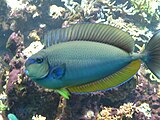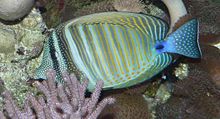Acanthuridae
| Surgeonfish Temporal range: Eocene to Recent
| |
|---|---|

| |
peduncle shows where the spine is folded in.
| |
| Scientific classification | |
| Domain: | Eukaryota |
| Kingdom: | Animalia |
| Phylum: | Chordata |
| Class: | Actinopterygii |
| Order: | Acanthuriformes |
| Suborder: | Acanthuroidei |
| Family: | Acanthuridae Bonaparte, 1835[1] |
| Genera | |
|
see text | |

Acanthuridae are a
Etymology and taxonomic history
The name of the family is derived from the Greek words akantha and oura, which loosely translate to "thorn" and "tail", respectively. This refers to the distinguishing characteristic of the family, the "
Subfamilies and genera

Acanthuridae contains the following extant subfamilies and genera:[4][1]
- Subfamily , 1929
- Subfamily Acanthurinae Bonaparte, 1835
- Tribe Acanthurini Bonaparte, 1839[5]
- Genus Acanthurus Forsskål 1775
- Genus Ctenochaetus Gill, 1884
- Tribe Prionurini J. L. B. Smith, 1966
- Genus Prionurus Lacépède, 1804
- Tribe Zebrasomini Winterbottom, 1993
- Genus Paracanthurus Bleeker, 1863
- Genus Zebrasoma Swainson, 1839
- Tribe Acanthurini Bonaparte, 1839[5]
Evolution and fossil record
There are several extinct genera known from fossils dating from the Eocene to Miocene:
Eocene genera
Oligocene genera
Miocene genera
Morphology
The distinctive characteristic of the family is that they have scalpel-like
Surgeonfishes sometimes feed as solitary individuals, but they often travel and feed in schools. Feeding in schools may be a mechanism for overwhelming the highly aggressive defense responses of small territorial damselfishes that vigorously guard small patches of algae on coral reefs.[7] Most species are fairly small, with a maximum length of 15–40 cm (6–15.5 in), but some in the genus Acanthurus, some in the genus Prionurus, and most species in the genus Naso may grow larger; the whitemargin unicornfish (Naso annulatus) is the largest species in the family, reaching a length of up to 1 m (3 ft 3 in). These fishes may grow quickly in aquaria, so average growth size and suitability should be checked before adding them to any marine aquarium.

A larval acanthurid, known as an acronurus, looks strikingly different from the juvenile and adult forms of the same individual. It is mostly transparent and tends to have a pelagic lifestyle, living in open water for an extended period of time before settling on the ocean bottom near the shore, where it develops into the juvenile and ultimately the adult form.[8]
Symbiotic bacteria
Acanthurids are the only known hosts of the bacteria of the genus
In the aquarium
Tangs are very sensitive to disease in the home aquarium. However, if the tang is fed enough algae and the aquarium is properly maintained disease should not be a problem. It is usually necessary to quarantine the animals for a period before introducing them to the aquarium.
Adults range from 15 to 40 centimetres (5.9 to 15.7 in) in length and most grow quickly even in aquaria. When considering a tang for an aquarium it is important to consider the size to which these fish can grow. Larger species such as the popular
Many also suggest adding aggressive tangs to the aquarium last as they are territorial and may fight and possibly kill other fish.
Tangs primarily graze on
Gallery
- Selected species
-
Achilles tang, Acanthurus achilles
-
Eyestripe surgeonfish, Acanthurus dussumieri
-
Powderblue surgeonfish, Acanthurus leucosternon
-
Doubleband surgeonfish, Acanthurus tennenti
-
Kole tang, Ctenochaetus strigosus
-
Bignose unicornfish, Naso vlamingii
-
Bluespine unicornfish, Naso unicornis
-
Red Sea sailfin tang, Zebrasoma desjardinii
-
Orangespot surgeonfish, Acanthurus olivaceus, being cleaned by two Hawaiian cleaner wrasse, Labroides phthirophagus
-
Regal tang, Paracanthurus hepatus in an aquarium
References
- ^ PMID 25543675.
- ^ a b Froese, Rainer, and Daniel Pauly, eds. (2007). "Acanthuridae" in FishBase. February 2007 version.
- .
- ISBN 978-1-118-34233-6. Archived from the originalon 2019-04-08. Retrieved 2023-07-10.
- ^ Samuel Hubbard Scudder (1884). "Nomenclator Zoologicus: An Alphabetical List of All Generic Names that Have Been Employed by Naturalists for Recent and Fossil Animals from the Earliest Times to the Close of the Year 1879". Bulletin (United States National Museum) (19).
- JSTOR 1443464.
- ^ Jonna, R. Jamil. "Acanthuridae (Surgeonfishes, tangs, unicornfishes)". Animal Diversity Web. Retrieved 2024-04-20.
- S2CID 206181801.
- S2CID 84816281.
- ISSN 0300-9629.
External links
 Media related to Acanthuridae at Wikimedia Commons
Media related to Acanthuridae at Wikimedia Commons- R. Jamil Jonna. "Acanthuridae: surgeonfishes, tangs, unicornfishes". Animal Diversity Web. University of Michigan Museum of Zoology.
- Sepkoski, Jack (2002). "A compendium of fossil marine animal genera". Bulletins of American Paleontology. 364: 560. Archived from the original on 2011-07-23.










